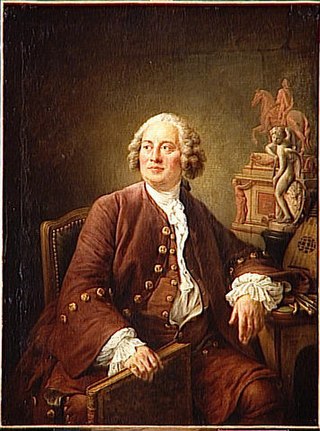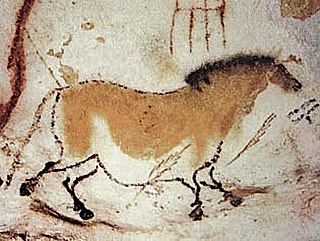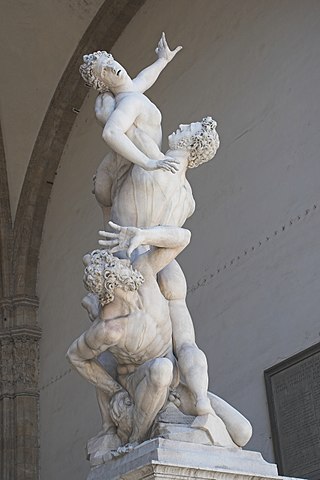
Giambologna, also known as Jean de Boulogne (French), Jehan Boulongne (Flemish) and Giovanni da Bologna (Italian), was the last significant Italian Renaissance sculptor, with a large workshop producing large and small works in bronze and marble in a late Mannerist style.

An equestrian statue is a statue of a rider mounted on a horse, from the Latin eques, meaning 'knight', deriving from equus, meaning 'horse'. A statue of a riderless horse is strictly an equine statue. A full-sized equestrian statue is a difficult and expensive object for any culture to produce, and figures have typically been portraits of rulers or, in the Renaissance and more recently, military commanders.

Edmé Bouchardon was a French sculptor best known for his neoclassical statues in the gardens of the Palace of Versailles, his medals, his equestrian statue of Louis XV of France for the Place de la Concorde ; and for the Fountain of Four Seasons in Paris. He was also a draftsman and painter, and made celebrated series of engravings of working-class Parisians.

Jacques François Joseph Saly, also known as Jacques Saly, French-born sculptor who worked in France, Italy and Malta. He is commonly associated with his time in Denmark he served as Director of the Royal Danish Academy of Art (1754–71). His most noteworthy work is the equestrian statue Frederik V on Horseback at Amalienborg.

Piazza della Signoria is a w-shaped square in front of the Palazzo Vecchio in Florence, Italy. It was named after the Palazzo della Signoria, also called Palazzo Vecchio. It is the main point of the origin and history of the Florentine Republic and still maintains its reputation as the political focus of the city. It is the meeting place of Florentines as well as the numerous tourists, located near Palazzo Vecchio and Piazza del Duomo and gateway to Uffizi Gallery.

The Loggia dei Lanzi, also called the Loggia della Signoria, is a building on a corner of the Piazza della Signoria in Florence, Italy, adjoining the Uffizi Gallery. It consists of wide arches open to the street. The arches rest on clustered pilasters with Corinthian capitals. The wide arches appealed so much to the Florentines that Michelangelo proposed that they should be continued all around the Piazza della Signoria.

Pietro Tacca was an Italian sculptor, who was the chief pupil and follower of Giambologna. Tacca began in a Mannerist style and worked in the Baroque style during his maturity.

A wax sculpture is a depiction made using a waxy substance. Often these are effigies, usually of a notable individual, but there are also death masks and scenes with many figures, mostly in relief.

Giovanni Francesco (Gianfrancesco) Susini was a Mannerist Florentine sculptor in bronze and marble.

Pierre Francqueville, generally called Pietro Francavilla, was a Franco-Flemish sculptor trained in Florence, who provided sculpture for Italian and French patrons in the elegant Late Mannerist tradition established by Giambologna.

The Crouching Venus is a Hellenistic model of Venus surprised at her bath. Venus crouches with her right knee close to the ground, turns her head to the right and, in most versions, reaches her right arm over to her left shoulder to cover her breasts. To judge by the number of copies that have been excavated on Roman sites in Italy and France, this variant on Venus seems to have been popular.

Horses have appeared in works of art throughout history, frequently as depictions of the horse in battle. The horse appears less frequently in modern art, partly because the horse is no longer significant either as a mode of transportation or as an implement of war. Most modern representations are of famous contemporary horses, artwork associated with horse racing, or artwork associated with the historic cowboy or Native American tradition of the American West. In the United Kingdom, depictions of fox hunting and nostalgic rural scenes involving horses continue to be made.

Hubert Le Sueur was a French sculptor with the contemporaneous reputation of having trained in Giambologna's Florentine workshop. He assisted Giambologna's foreman, Pietro Tacca, in Paris, in finishing and erecting the equestrian statue of Henri IV on the Pont Neuf. He moved to England and spent the most productive decades of his working career there, providing monuments, portraits and replicas of classical antiquities for the court of Charles I, where his main rival was Francesco Fanelli.

The Breeders’ Cup Trophy is an authentic and totally faithful bronze reproduction of the Torrie horse. The original was created in Florence, Italy by Giovanni da Bologna, around the late 1580s. Each year the Breeders' Cup World Thoroughbred Championships award to the winner of each of 14 races a garland of flowers draped over the withers of the winning horse and four Breeders' Cup Trophy presented to the connections of the winners.

Smugglerius is an écorché sculpture of a man posed in imitation of the ancient Roman sculpture known as the Dying Gaul. The original bronze cast was made in 1776 by Agostino Carlini for William Hunter, first Professor of Anatomy at the Royal Academy Schools, from the body of a muscular criminal, flayed after he was hanged at Tyburn. The criminal was thought to be a smuggler, and so the cast of his body was given the mocking cod Latin name "Smugglerius".

The Equestrian statue of Bartolomeo Colleoni is a Renaissance sculpture in Campo Santi Giovanni e Paolo, Venice, Italy, created by Andrea del Verrocchio in 1480–1488. Portraying the condottiero Bartolomeo Colleoni, it has a height of 395 cm excluding the pedestal. It is the second major equestrian statue of the Italian Renaissance, after Donatello's equestrian statue of Gattamelata (1453).

An equestrian statue of King Frederick V of Denmark stands in the center of Amalienborg Square, Copenhagen, framed by the four symmetrical wings of the Amalienborg palace. The statue portrays the king in classic attire, crowned with laurels and with his hand outstretched, holding a baton. Commissioned by the Danish East India Company, it was designed in Neoclassical style by Jacques Saly in 1768 and was cast in bronze in 1771. The apparent dignity and tranquility in the depiction of the king is typical of Danish representations of monarchs. It is considered to be one of the notable equestrian monuments of its time.

The Equestrian Monument of Cosimo I is a bronze equestrian statue executed by Giambologna from 1587 to 1594, and erected in 1594 in the Piazza della Signoria in Florence, Tuscany, Italy.

Abduction of a Sabine Woman is a large and complex marble statue by the Flemish sculptor and architect Giambologna. It was completed between 1579 and 1583 for Cosimo I de' Medici. Giambologna achieved widespread fame in his lifetime, and this work is widely considered his masterpiece. It has been in the Loggia dei Lanzi, Florence, since August 1582.

Italian Renaissance sculpture was an important part of the art of the Italian Renaissance, in the early stages arguably representing the leading edge. The example of Ancient Roman sculpture hung very heavily over it, both in terms of style and the uses to which sculpture was put. In complete contrast to painting, there were many surviving Roman sculptures around Italy, above all in Rome, and new ones were being excavated all the time, and keenly collected. Apart from a handful of major figures, especially Michelangelo and Donatello, it is today less well-known than Italian Renaissance painting, but this was not the case at the time.




















